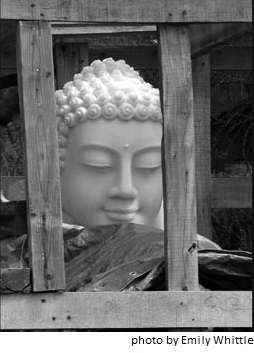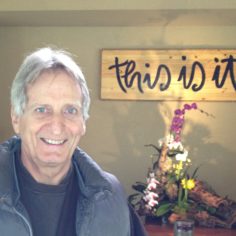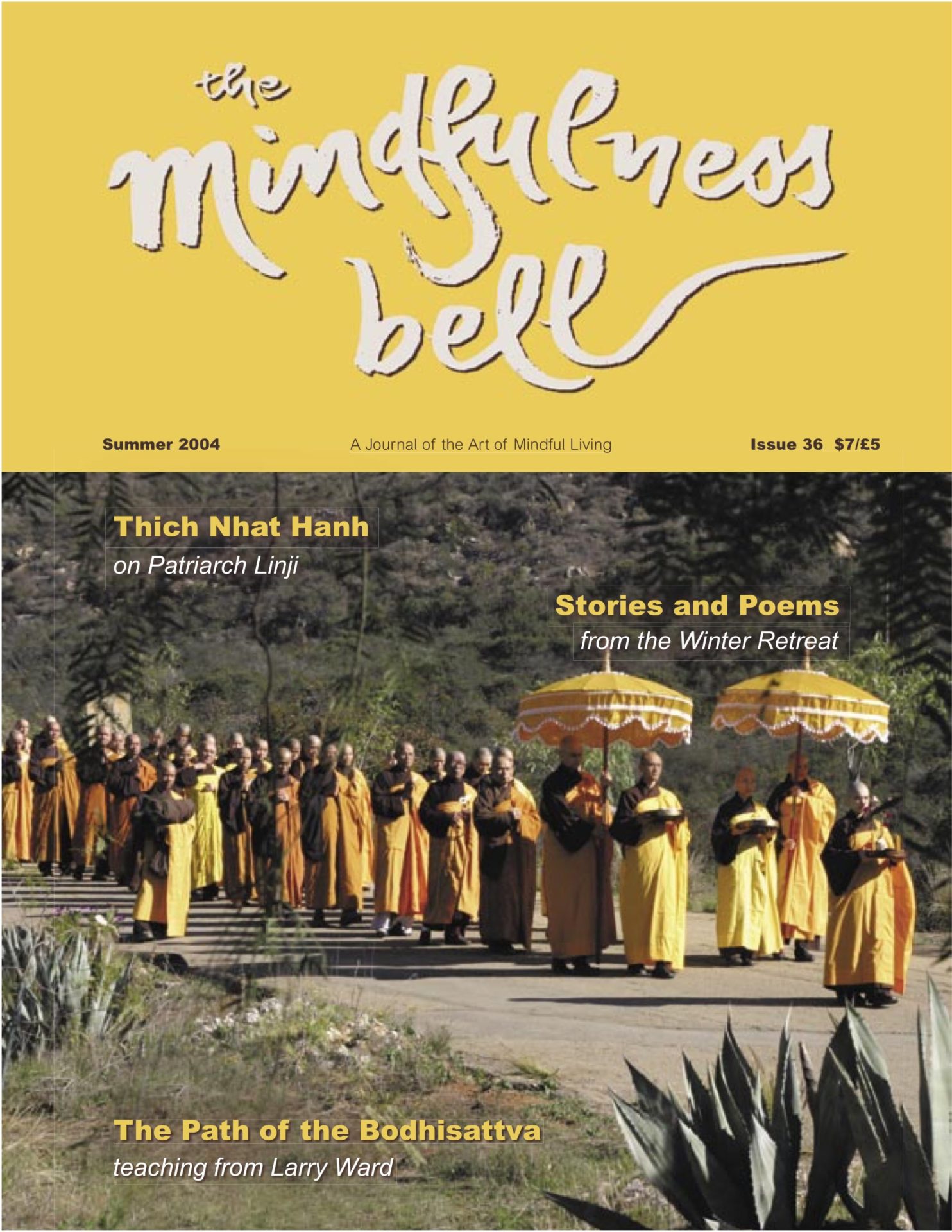Skillful Means for Emotional Healing
By John Bell in June 2004
In the mid-1990s, John Bell began leading workshops on handling stress for the young people and staff in the YouthBuild programs throughout the United States. At the workshop, John introduced them to meditation and to methods of emotional healing.
John has been exploring ways of combining meditation and methods of emotional healing for many years.
Skillful Means for Emotional Healing
By John Bell in June 2004
In the mid-1990s, John Bell began leading workshops on handling stress for the young people and staff in the YouthBuild programs throughout the United States. At the workshop, John introduced them to meditation and to methods of emotional healing.
John has been exploring ways of combining meditation and methods of emotional healing for many years. In one pivotal insight, he noticed that feelings often come up when sitting in meditation and that if we pay specific attention to them, either then or immediately after sitting, they will naturally release themselves and became conscious doors for liberation.
Several years ago John began offering an annual Day of Mindfulness focusing on mindfulness and emotional healing for folks from the greater Boston area Sanghas.
Each year, more people attend. In the fall of 2003, in Berkeley, California, Dharma teacher Lyn Fine and John teamed up to offer a weekend retreat on the topic. Another one is being offered this June, in Connecticut.
This article offers an invitation to use emotions as an object of meditation. It highlights some of the methods John uses to uncover, hold, and transform difficult feelings.

Feelings
There are some things we know about feelings. They are impermanent, always changing. They often connect us most directly with ourselves. Typically feelings are problematic, a source of confusion and suffering. Feelings are usually riddled with our judgments—I should feel this way, or, I shouldn’t feel that way; this feeling is bad, that one good. In the midst of the confusion we try our best to handle them. Often we wind up suppressing or repressing the feeling that is present, or perhaps acting out the feeling inappropriately. This leads to more inner turmoil and distress. Hurtful experiences, plus our judgments about the feelings that accompany those experiences, soon lead us to feel that there is something wrong, or that “I’m not okay.” This negative self-judgment obscures our ultimate nature.
Five Practices for Handling Feelings
In a Dharma talk reprinted in the Fall 2000 Mindfulness Bell, Thich Nhat Hanh teaches five main practices for handling feelings, each of which is intimately connected to the others. As a brief review, the five are:
- "Blue sky": Ground ourselves in the ultimate The blue sky is a metaphor for the nature of things, ultimate reality, our home. It is always there behind the local, historical dimension that we get conditioned to think is reality. The blue sky is the is-ness, the ok-ness. To describe it, we use words like “spacious, free, happy, connected, oneness, well-being, no separation, no separate self ”. Each of us has experienced our blue sky nature many, many times. Perhaps in music, love-making, nature, a moment of being “awake.” In C.S. Lewis’s happy phrasing, “surprised by joy!”
- "Noting": Learn to observe feelings coming and going. After establishing ourselves solidly in the breath, we allow the different feelings to arise and fall away like waves on the We can use helpful phrases like “feeling sad” (or, “angry, jealous, fearful”, and so on), or “this feeling too” to whatever comes. Relating back to the “blue sky” practice, we can be aware of different feelings like clouds moving across the blue sky.
- "Change the peg": Move attention off suffering, onto something positive or interesting, or at least In older methods of carpentry, pieces of wood were attached with a peg. Sometimes a rotten peg would have to be replaced by pounding a new one into the same hole. Originally taught by the Buddha, Thay uses this metaphor to point to the many tools at our disposal for “watering the positive seeds.” When a negative feeling seems to dominate our awareness, we can deliberately choose to get our attention off our troubles by reading a poem, listening to music, taking a walk, reciting a sutra, caring for another person. This list is unlimited.
- "Taking the hand of suffering": Embracing what Accepting, befriending feelings. Thay urges us not to treat our sadness or unhappiness as an enemy. “Dear anger, I recognize you. Come, stay with me. I know you are suffering. I know how to care for you.” The practice is to just be with the feeling, not get overwhelmed or swept away, and not run away. This is a variation of “noting.” “So this is what sadness feels like. Hmm. Very interesting.” Kind and gentle.
- "Look deeply”: Examine the roots of With persistent feelings that seem to have a deep hold on us and won’t go away, we can practice exploring the roots of distressed feelings. In my experience, the roots are either in repeated experiences of hurt beginning early in our lives, or in a severe incident of trauma or hurt at any vulnerable moment along the way. What is helpful is to have a friend listen warmly and attentively while we explore the past. Typically tears and fears and laughter and anger will accompany the release of deep and long-lasting hurts. The emotional release will allow understanding to arise. “Oh, that’s why I have always felt like that!” Insight.
Each of these five practices is deep. Each can be greatly elaborated and extended over time. Each can be practiced individually or in community. We can take feelings as an object of meditation. Our Sanghas can help us practice emotional healing. We can learn to deliberately deepen safety to explore feelings. We can create space to allow for feelings. We can be internally attentive to our judgments about feelings. Over time, we can develop comfort and skill with any and all of the five practices mentioned above. Here, let us focus on two practices, the first and the last, “Blue Sky” and “Looking Deeply.”
Blue Sky Practice
In the Spring of 2001 at a retreat called “Mindfulness and Emotional Healing” for the Boston area Sanghas, Order of Interbeing member Joanne Sunshower and I introduced a “Blue Sky Practice.” We started by inviting everyone to sing Irving Berlin’s happy and familiar song, “Blue Skies”:
Blue skies, smiling at me
Nothing but blue skies do I see
Blue birds singing a song
Nothing but blue birds from now on
We talked about our blue sky nature and how feelings and other mind states are like weather passing through the blue sky. If we identify with the weather we can easily forget that the blue sky is always there and holds all weather, and that weather is temporary. Finding ways of touching where we live, our ultimate nature, our blue skies, is a deep and useful practice.
To explore this we asked people to break into pairs, with each taking an uninterrupted ten minute turn to tell the listener about times we experienced blue sky. We asked them to think of this as a two-person Dharma discussion, listening without interruption.
After breathing in silence, the speaker might remember a time he or she felt whole, connected, completely loved, one with everything, in touch with unlimited compassion, or other aspects of the ultimate dimension. Or she might look around and touch the blue sky in the present.
We asked the listener to assume the attitude of Buddha. How would Buddha look at the speaker? How would Buddha listen? What attitude would Buddha have toward the speaker? These questions can be helpful when we remember that what Buddha would be seeing is the Buddha nature of the speaker.
In sharing about the experience afterwards, practitioners reported delight in being able to bring memories of blue sky times into present awareness, or to simply look, listen, and feel the blue skyness of
the moment. For some, tears flowed surprisingly quickly when they turned their attention toward the ultimate reality. Basking in the warm attention of the listener seemed to help the process. This practice has elicited similar responses each time I have introduced it over the past several years.
Practice of Looking Deeply at Suffering
Grounding oneself in the ultimate dimension can form a solid base for exploring our pain in the relative dimension. The Blue Sky practice can form an anchor. Repeatedly, my experience has been that when I can listen deeply to another person for a long enough time, the person often spontaneously moves toward looking deeply at the roots of their pain. Why do we do this so reliably? My own practice over the years convinces me that it is a natural process.

Our inherent Buddha nature gets obscured by hurt, oppression, misinformation, lack of information, family conditioning, inherited cultural beliefs, and a million other forms of harm. Such accumulated hurts shape our patterns of perception, ideas of self, and other mental formations. Mindfulness meditation, practiced with diligence and persistence, can eventually penetrate these veils and once again put a person in touch with the freedom and equanimity of the blue sky. Paying attention to feelings, looking at suffering, is not hard to do in a mindfulness context. It is a necessary and inevitable process along the path of liberation. Recasting the Four Noble Truths to focus on emotional hindrances might sound something like this:
There is suffering. Here we are speaking of emotional distress and physical hurt. Buddha named suffering as the first truth to help us acknowledge and accept suffering rather than deny or avoid it. All Western therapeutic schools likewise state that healing begins when a person faces the pain. “It hurts.”
There is a cause of suffering. Buddha taught that the cause is ignorance of reality, is thinking there is independent existence, is not understanding the impermanent nature of things and trying to hold on to what must change. Wrapped around these big issues for any individual are the scars of untold layers of hurtful experiences—things that happened to the person because he or she is born into a whole world full of suffering and falseness. Things like being unloved, scorned, rejected, not valued, humiliated, abused, disrespected, mis-educated, oppressed, ignored, not welcomed, lied to, mistreated, made to feel powerless, misled, physically hurt, pampered into numbness, not accepted, insulted, demeaned, or made to be afraid.
There is a way out of suffering. For Buddha, understanding the nature of reality meant liberation from suffering. Along the emotional healing path, increased freedom from suffering comes as a person heals past trauma, reevaluates the past, sheds old patterns of thought and behavior, and gradually identifies with a healthier sense of self. As many people have noted, one has to have a strong, integrated ego in order to transcend the ego and move to the deeper insights that Buddha taught. Buddhist psychology speaks of purification as a step towards liberation.
The practice of the path is the means for ending suffering. Buddha put forth a comprehensive Eightfold Path—a set of moral guidelines, concentration practices, conceptual directions, and practices for daily living that, if followed diligently, can lead to insight and the transformation of suffering. What might be some elements of the path to end emotional suffering? Here are ones that I have found useful and consistent with Buddhist teachings.
- Cultivate a noble view of human beings. Know that every human being, by nature, is Buddha I use this description: By nature, human beings are
- inherently valuable
- deeply caring
- enormously intelligent
- immensely powerful
- infinitely creative
- naturally cooperative
- innately joyful
Whenever I’ve asked a group of people to repeat these words out loud, the tone rises immediately. Why? Because the words reach for the noblest of human characteristics, and most of us intuitively know that we are these things, if we could only be free of what holds us back. I could say that by nature, human beings are impermanent, aimless, and empty, but these words don’t instantly resonate with most people in the West like the first set of words!
- Listen deeply. What are the elements of deep listening? We practice these in our Sanghas.
- Hold the person in high regard; visualize their Buddha nature.
- Treat the person with complete respect.
- Be present and
- Assume the person knows best how to lead his or her life.
- Communicate acceptance and lack of judgment.
- Give your undivided attention, focused concentration, and mindful
- Encourage awareness and recognition of feelings; recognize that release is a key component of healing.
Deep listening is a powerful tool for healing. Our listening can improve with practice. Invoking Avalokiteshvara’s name states: “We aspire to learn your way of listening in order to help relieve suffering in the world. You know how to listen in order to understand. We invoke your name in order to practice listening with all our attention and openheartedness. We will sit and listen without any prejudice, without any judging or reacting. We will sit and listen so attentively that we will be able to hear what the other person is saying and also what is being left unsaid. We know that just by listening deeply we already alleviate a great deal of pain and suffering in the other person.”

- Hold some understanding of the impact of distress. Hurts lead a person to develop self-defense patterns of thought, feelings, and behaviors. Buddhist psychology calls them “kleshas”—powerful reactions that drive our behavior. Initially developed as survival mechanisms to deal with the hurt, these patterns take on a life of their own and persist long after the hurtful experiences have passed. In other words, the negative seeds have received too much water! They tend to control our vital energies and obscure our inherent nature. The most persistent of these patterns are chronic—that is, they operate almost all the time and a person tends to identify with them. Think of someone who is chronically angry, or chronically depressed, or always ready to criticize any good idea, or can be counted on to be the center of attention, or is painfully shy.
- Practice separating a person from his or her patterns. Always view that person as wholesome and worthwhile, deserving nothing less than complete Always view their patterns as a map of the ways they were mistreated or hurt; not an inherent part of their being, but an add-on. Nurturing compassion is another form of this practice. For example, Thay suggests we practice visualizing our father or our mother as a six-year-old child. Even if we have suffered greatly from our parents, seeing them as younger can open our hearts— we might see them as innocent and pure-hearted, or we might see them already hurt at an early age, and set up to pass that hurt on to us.
- Welcome feelings. One level of healing happens as a person releases the emotional distresses that are the glue of the patterns. Crying, laughing, shivering, feeling hot with anger are outward signs of the release of distress feelings. This release is natural to all human beings, as can be observed most readily in small children: when hurt they cry. In my experience, most people can learn how to accept and express their pent up feelings appropriately rather than suppress them or act them out. Dealing with feelings with mindfulness is a learned practice. We can learn to feel them without getting overwhelmed by them or identifying ourselves with them.
- Practice appreciation and validation. “Violence never ceases by violence, but only by love,” said the Buddha. Our hurts have caused us to direct huge amounts of internal violence towards ourselves in the form of self-criticisms, low expectations, lack of self-worth, and so on. Such internal negative chatter cannot withstand a steady dose of self-appreciation. Repeatedly telling yourself things like “I forgive myself,” or “You are fine just the way you are,” or “I’ll never give up on you,” done with mindfulness and persistence, can bring healing tears of release and joy. Loving kindness, or metta meditation points us to our inherent well-being: may I be filled with love and compassion; may my body be peaceful and at ease; may I be safe from fear and harm; may I be happy; may I be healthy. Directed towards oneself, metta is a form of self-appreciation that serves to counter the sometimes constant drone of negative self-talk. Directed towards others, it becomes an effective practice of appreciating others that also has a deep healing effect on oneself.
- Hold a direction towards our inherent nature. Here is where we circle back to the Blue Sky Regular practice of noticing the presence of the good, the beautiful, the true builds our strength and can put us increasingly in touch with the reality of our inherent nature. In a Dharma talk (November 25, 1999, Plum Village), Thay said: “To allow ourselves to be overwhelmed by the negative feeling when we touch what is wrong, is not a good thing to do. Therefore we should…recognize the positive elements for our nourishment and healing.”
Skillful Means
Of course, all of these practices, concepts, and methods are simply skillful means, as are all Buddhist teachings—potentially helpful aids along the path of liberation. As layers of suffering are released, practices change or are sloughed off. Eventually, or at least for longer and longer moments, we won’t have to practice metta, we will be living metta. We won’t have to practice listening deeply, we will be present. We won’t have to practice welcoming feelings, we will accept whatever comes. And so on. But along the way, such practices are powerful compasses to help steer us through the prevailing fog of falsehood. So, in addition to sitting in silence, we may also have to let ourselves do a lot of crying and laughing, and feeling scared and angry. We can become very skillful at providing the safety, clarity, boundaries, encouragement, and practices for our Sangha sisters and brothers to do mindfulness-based emotional healing. All it takes is practice.


